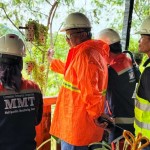Siocon is prime example
Siocon is a rich farming and fishing town on the western coast of Zamboanga del Norte. Despite suggestions that the presence of a large-scale mining firm in Canatuan, a mountain community some 25 kilometers northeast, has harmed its agricultural productivity, Siocon remains one of the province’s top rice producers – proof that responsible mining practices can coexist with agriculture.
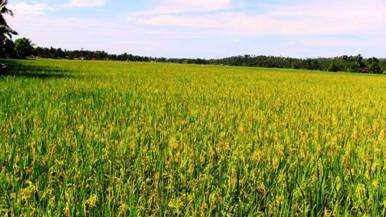
|
The town of Siocon remains Zamboanga del Norte’s top rice producer. In 2010, average harvest for irrigated rice lands was 3.8 metric tons per hectare while rain-fed rice lands yielded 3.5 mt/hectare. Photos show rice fields at Barangay Siay in Siocon waiting for harvesting. Despite suggestions that the presence of large-scale mining in Canatuan has harmed agricultural productivity, the steady rate of rice production since the year 2000 is proof that responsible mining can coexist with agriculture.
|
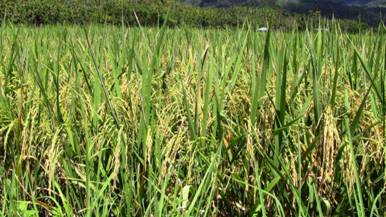
Which is why Sebastian “Boy” Ates could only shake his head in exasperation when he hears remarks that rice production in Siocon has been adversely affected since TVI Resource Development Philippines, Inc. (TVIRD) began operations in Canatuan in mid-2004. “Boy” to fellow farmers in his hometown has been with the Municipal Agriculturist’s Office as Rice Technician for almost two decades now. His being in the position has given him the advantage of knowing each and every farmer’s year-round rice produce as well as problems because he regularly visits their farms.
“Those who say that our rice production has been reduced these past years have not done their homework,” Ates laments.
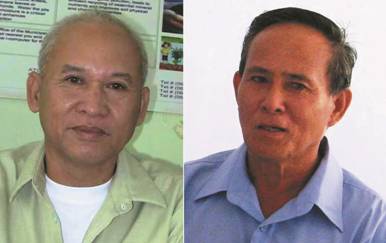
|
Siocon Councilor Andres Micubo (right): “There are times we have a bountiful harvest and there are also times that our production is not so good – and for many different reasons. Mining has nothing to do with it.”
Siocon Councilor Andres Micubo, former chairman of the town’s Committee on Agriculture and also a rice farmer himself, shares Ates’ sentiment. Micubo stresses that rice production in Siocon remains the same since 2000. “Farming is also like business. There are times we have a bountiful harvest and there are also times that our production is not so good – and for many different reasons. Mining has nothing to do with it.” |
“Rice pests and typhoons like Ondoy and Frank, both of which hit Siocon, affected our harvest,” he explains. “The high cost of fertilizers and pesticides is also a major problem of poor farmers. The government recognizes this, which is why there’s a subsidy provided to them. The subsidy may be small, but it still is a welcome help to rice farmers. I should know because I raised my family from the income I am getting from my rice lands.”
He points out further that his town lacks an irrigation system that can serve all rice farmers of his municipality. “We have enough sources of water. But not the irrigation system. And building irrigation canals will cost millions of pesos. We simply do not have the money. We might be better off next year because our Mayor Ceasar Soriano was able to secure funds for the repair of the damaged irrigation system in his barangay.”
Micubo is thankful to TVIRD for repairing a portion of the irrigation system that serves the people in the villages of Siay, Datu Saililah, Malipot, M. Francisco and Tibangai.
Ates, for his part, says that in 2008 Siocon was declared by the government’s Department of Agriculture (DA) as the top rice producing town in the province of Zamboanga del Norte. “And that happened despite the fact that there is an ongoing mining operation up in Canatuan,” he adds.
He explains that since the ‘90s up to the present, the average yield of an irrigated and non-irrigated hectare of riceland in Siocon remains the same per cropping. “In order to have a yield increase, a rice farmer must spend more than the usual P20,000 for fertilizer, labor cost and pesticides.”
Ates says records in his office will show that yield per hectare of irrigated and rain fed rice lands are even increasing from 2000 to 2010.
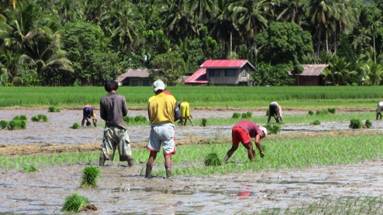
|
Farmers tend their rice farm as planting season has started in Barangay Malipot of Siocon. Below, Municipal Agriculture technicians work at their demonstration farm in Barangay Datu Saililah, Siocon.
|
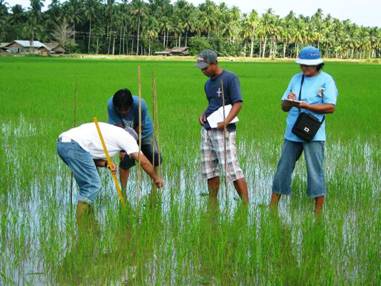
“Siocon has a total of 1,600 hectares of irrigated rice lands and another 550 hectares of rain fed rice lands. “Our last harvest in 2010 showed that the average yield of one hectare irrigated rice lands was 3.8 metric tons or 3,800 kilograms of palay, while average yield of a rain fed rice land is 3.5 metric tons or 3,500 kilograms.”
“That was also the average yield of one hectare of irrigated and rain fed rice lands from 2008 to 2009,” he averred showing its tables.
|
Year |
Irrigated Yield (tons/hectare) |
Non-Irrigated Yield (tons/hectare) |
|
2000 – 2005 |
3.5 metric tons (or 3,500 kg) |
3.2 metric tons (or 3,200 kg) |
|
2006 – 2007 |
3.6 metric tons (or 3,600 kg) |
3.4 metric tons (or 3,400 kg) |
|
2008 – 2010 |
3.8 metric tons (or 3,800 kg) |
3.5 metric tons (or 3,500 kg) |
Micubo added that Lituban and Siocon Rivers remain the most reliable sources of water for irrigation projects in his municipality. Tributaries of these rivers include the Cusan, Canatuan and Lumot creeks, all of which emerge from within and around the Canatuan mine site.
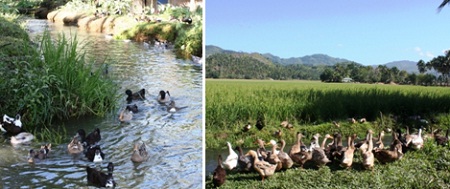
|
A paddling of ducks (left photo) and a flock of geese (right) enjoy the clean waters of an irrigation canal situated downstream Siocon River. The Lituban and Siocon Rivers remain the most reliable sources of water for irrigation projects in Siocon. Tributaries of these rivers include the Cusan, Canatuan and Lumot creeks, all of which emerge from within and around the Canatuan mine site. Below, young children and a carabao share the refreshing waters of Lituban River.
|
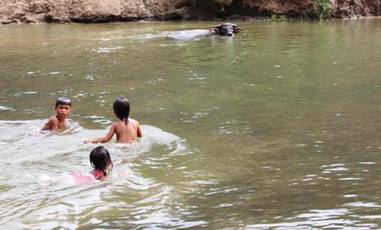
The Canatuan River watershed represents less than 1% of the Siocon River watershed while the areas disturbed by the TVIRD mining operations encompass even less than this. As part of TVIRD’s erosion control measures, the company built six sediment control structures to capture sediment from the disturbed areas and prevent siltation of Canatuan Creek and the Lituban and Siocon Rivers. In addition, TVIRD has planted over 200,000 trees – with an 80% survival rate since 2002, prior to the company operations. Additional erosion control measures have also been implemented, such as slope benching, terracing, planting of grasses, water diversion control canals, and a variety of natural techniques using local materials.
Christopher Tolentino, TVIRD Environment Department’s Water Monitoring foreman checks the water pH level at the spillway of the Sulphide Dam. He leads his team in getting daily and weekly water samples from Canatuan Creek as well as the Lituban and Siocon Rivers. He explains, “My job requires me to monitor those rivers every day. And I like to think that am doing it well because I want these rivers to continue giving life to the people of my own town. The majority of Sioconians depend on water for their livelihood.”
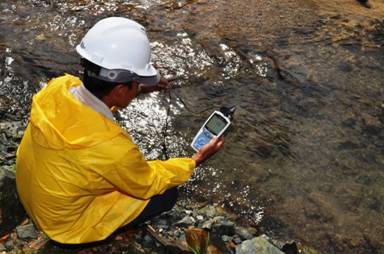
|
Christopher Tolentino, Water Monitoring foreman of TVIRD’s Environment Department, says Canatuan Creek and its tributaries flow to the Lituban and Siocon Rivers, and then to Siocon Bay.
|
Tolentino, a native of Barangay Lituban also in Siocon town, leads his team in getting daily and weekly water samples from Canatuan Creek as well as the Lituban and Siocon Rivers. The samples are then submitted for analysis at the company’s Assay Laboratory. His team also does its own field analysis of the samples for further monitoring. An employee of TVIRD since 2004, Tolentino has been diligently monitoring the water quality within these stream and rivers since the first phase of the company’s operations – the Gold-Silver phase, up to the present, the second phase – Copper-Zinc phase.
“My job requires me to monitor those rivers every day,” he explains. “And I like to think that am doing it well because I want these rivers to continue giving life to the people of my own town. The majority of Sioconians depend on water for their livelihood.”
Siegfred Bueser, a member of the Multipartite Monitoring Team (MMT) representing the local government of Siocon says reports of decreasing rice production in the town are “a big lie.”
“I have spent 45 years of my life in Siocon,” he stresses. “My grandparents and parents were also farmers, so I know the truth!”
The MMT is the monitoring body of the Mines Rehabilitation Fund Committee (MRFC), one of the legal requirements being followed by minerals development firms under the Philippine Mining Act of 1995. MMT’s membership includes representatives of government regulatory agencies, such as the Department of Environment and Natural Resources and its two sub-agencies, the Mines and Geosciences Bureau and the Environmental Management Bureau (EMB); representatives of host local governments, including the municipality of Siocon, the province of Zamboanga del Norte, and Barangay Tabayo, which encompasses Canatuan. Also represented in the MMT are the Subanon indigenous people (TVIRD’s hosts), Siocon-based NGOs, and TVIRD. One of MMT’s functions is to monitor the bodies of waters within the mine site, including the tailings storage facilities, as well as rivers outside the mine area. This includes the Siocon and Lituban Rivers.
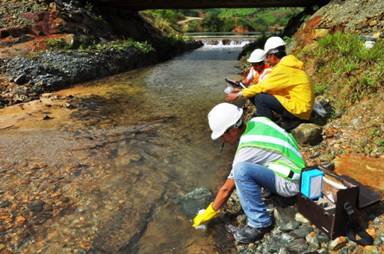
|
Joseph Glodove (in green safety vest), Christopher Tolentino (middle) and Fernando Billones, all belonging to the Water Monitoring Team of TVIRD, take water samples and monitor the water quality below the spillway of the Sulphide Dam for dissolved oxygen (DO), water acidity and alkalinity. Aside from the daily monitoring done by the group, a Multi-Partite Monitoring Team also regularly checks the bodies of waters within the mine site, the tailings storage facilities, as well as the rivers outside the mine area, including Lituban and Siocon Rivers.
|
Bueser, who has been a local government employee of Siocon for two decades, says he saw how badly contaminated Siocon and Lituban rivers were during the regime of small-scale miners in Canatuan in the mid to late ‘90s. “EMB records will show the deplorable status of these two rivers, including the Cusan and Canatuan creeks during those days,” he says.
“So far, results of our monitoring show that the Siocon and Lituban Rivers and sea waters in Sta. Maria and Siocon are free of contaminants from the TVIRD mine site,” he avers. “To ensure objectivity, we use third party laboratories in Manila to analyze the water samples — and not just the Assay Laboratory of the company.”
Boy Ates loves his work, since he, too, has a small rice land that he wishes to till and manage himself when he retires. Farming, he says, is in his blood, being a son of a farmer. His ardent wish is for farmers in his hometown to one day have the adequate irrigation system they badly need. He may not realize it during his lifetime, but he is sure that it is not impossible because the Siocon and Lituban Rivers are being taken good care of by everybody. (Lullie Micabalo)
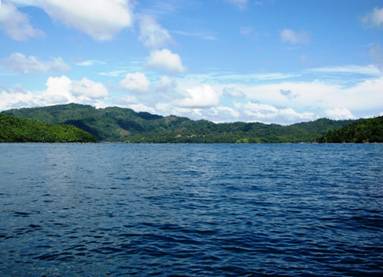
|
The calm sea waters off Sta. Maria is part of the Siocon Bay. This productive body of water provides livelihood to the Muslim community of Barangay Sta. Maria, Siocon.
|
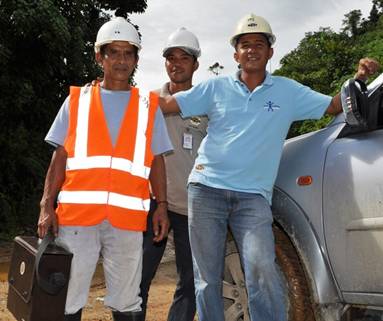
|
TVIRD Water Monitors. (Left to Right) Fernando Billones, Water Monitoring Foreman Christopher Tolentino and Environment Supervisor Frank Jardeliza pose for the camera after a day’s work of ensuring that the water quality within and outside TVIRD’s mine area remain safe for both the environment and people.
|

